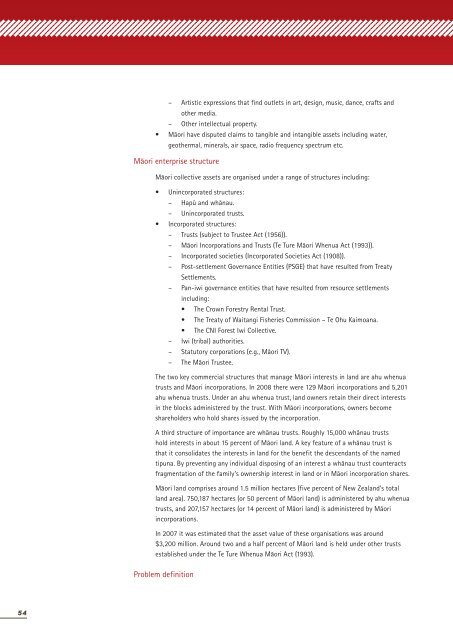MÄÂori Enterprise and the New Zealand Capital ... - Te Puni Kokiri
MÄÂori Enterprise and the New Zealand Capital ... - Te Puni Kokiri
MÄÂori Enterprise and the New Zealand Capital ... - Te Puni Kokiri
You also want an ePaper? Increase the reach of your titles
YUMPU automatically turns print PDFs into web optimized ePapers that Google loves.
– Artistic expressions that find outlets in art, design, music, dance, crafts <strong>and</strong><br />
o<strong>the</strong>r media.<br />
– O<strong>the</strong>r intellectual property.<br />
• Mäori have disputed claims to tangible <strong>and</strong> intangible assets including water,<br />
geo<strong>the</strong>rmal, minerals, air space, radio frequency spectrum etc.<br />
Mäori enterprise structure<br />
Mäori collective assets are organised under a range of structures including:<br />
• Unincorporated structures:<br />
– Hapü <strong>and</strong> whänau.<br />
– Unincorporated trusts.<br />
• Incorporated structures:<br />
– Trusts (subject to Trustee Act (1956)).<br />
– Mäori Incorporations <strong>and</strong> Trusts (<strong>Te</strong> Ture Mäori Whenua Act (1993)).<br />
– Incorporated societies (Incorporated Societies Act (1908)).<br />
– Post-settlement Governance Entities (PSGE) that have resulted from Treaty<br />
Settlements.<br />
– Pan-iwi governance entities that have resulted from resource settlements<br />
including:<br />
• The Crown Forestry Rental Trust.<br />
• The Treaty of Waitangi Fisheries Commission – <strong>Te</strong> Ohu Kaimoana.<br />
• The CNI Forest Iwi Collective.<br />
– Iwi (tribal) authorities.<br />
– Statutory corporations (e.g., Mäori TV).<br />
– The Mäori Trustee.<br />
The two key commercial structures that manage Mäori interests in l<strong>and</strong> are ahu whenua<br />
trusts <strong>and</strong> Mäori incorporations. In 2008 <strong>the</strong>re were 129 Mäori incorporations <strong>and</strong> 5,201<br />
ahu whenua trusts. Under an ahu whenua trust, l<strong>and</strong> owners retain <strong>the</strong>ir direct interests<br />
in <strong>the</strong> blocks administered by <strong>the</strong> trust. With Mäori incorporations, owners become<br />
shareholders who hold shares issued by <strong>the</strong> incorporation.<br />
A third structure of importance are whänau trusts. Roughly 15,000 whänau trusts<br />
hold interests in about 15 percent of Mäori l<strong>and</strong>. A key feature of a whänau trust is<br />
that it consolidates <strong>the</strong> interests in l<strong>and</strong> for <strong>the</strong> benefit <strong>the</strong> descendants of <strong>the</strong> named<br />
tipuna. By preventing any individual disposing of an interest a whänau trust counteracts<br />
fragmentation of <strong>the</strong> family’s ownership interest in l<strong>and</strong> or in Mäori incorporation shares.<br />
Mäori l<strong>and</strong> comprises around 1.5 million hectares (five percent of <strong>New</strong> Zeal<strong>and</strong>’s total<br />
l<strong>and</strong> area). 750,187 hectares (or 50 percent of Mäori l<strong>and</strong>) is administered by ahu whenua<br />
trusts, <strong>and</strong> 207,157 hectares (or 14 percent of Mäori l<strong>and</strong>) is administered by Mäori<br />
incorporations.<br />
In 2007 it was estimated that <strong>the</strong> asset value of <strong>the</strong>se organisations was around<br />
$3,200 million. Around two <strong>and</strong> a half percent of Mäori l<strong>and</strong> is held under o<strong>the</strong>r trusts<br />
established under <strong>the</strong> <strong>Te</strong> Ture Whenua Mäori Act (1993).<br />
Problem definition<br />
54

















